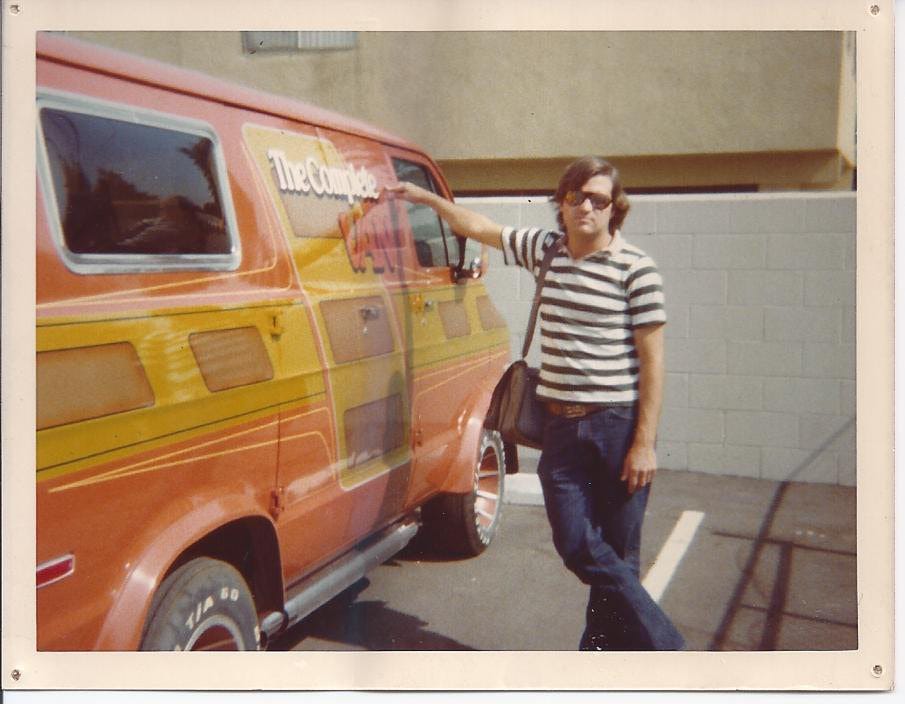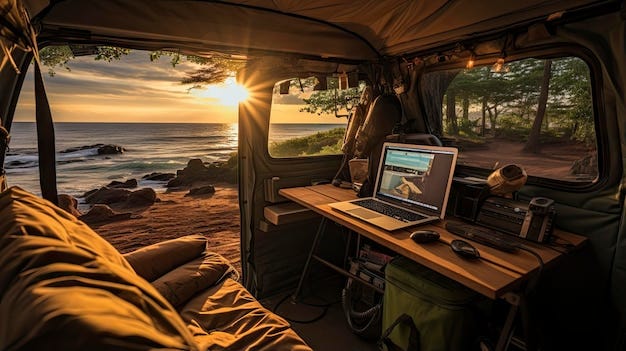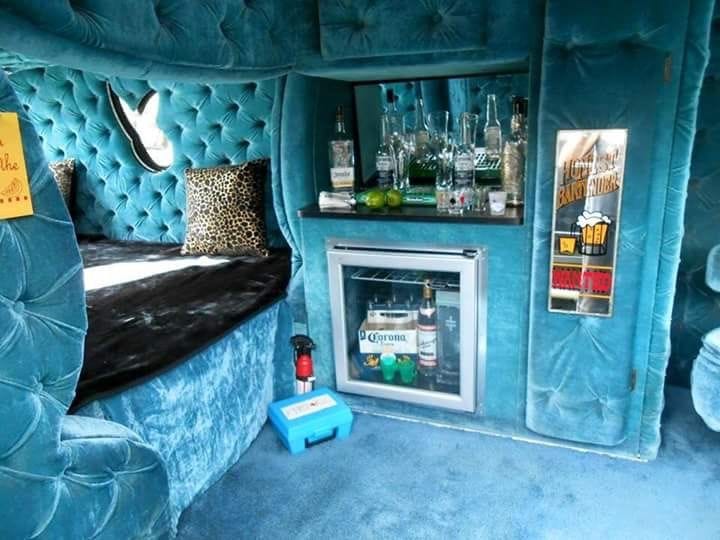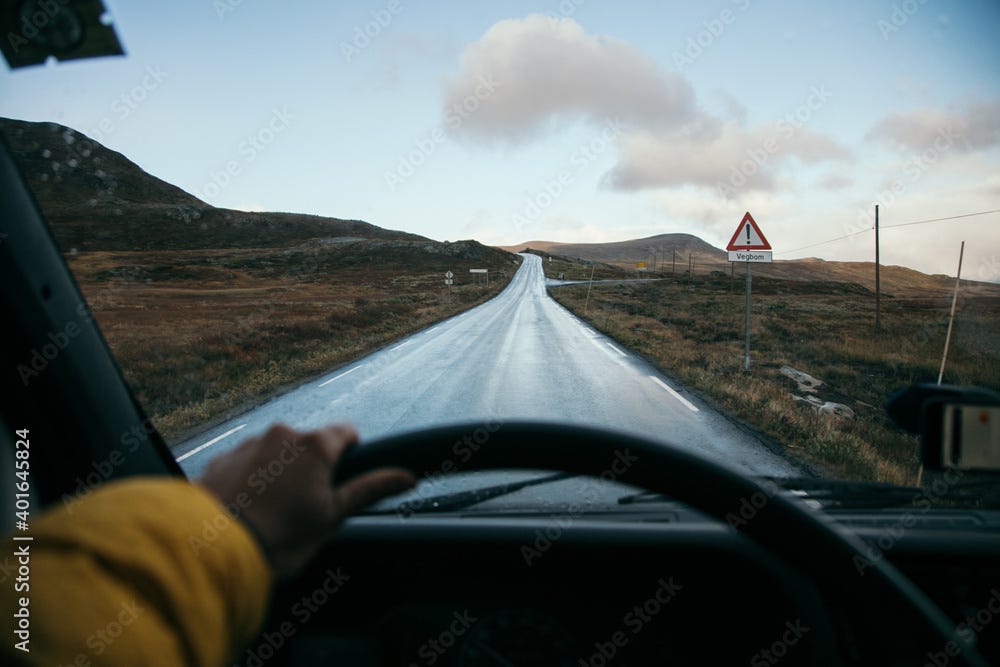In 1976 when I finished writing and publishing my first book, “The Complete Van Book,” there were less than 10 years left until the whole customized van craze of the 70’s ran its course. Enthusiasts took delivery vans made by Ford, Dodge, and Chevrolet, adorned them with wild metalflake paint jobs, molded flares around the wheel wells, cut oval windows into the vans’ side panels and sunroofs into their flat tops, and transformed the raw metal-ribbed interiors into dream palaces complete with flocked-wall treatments, shag carpets, velveteen convertible sofa-beds, refrigerators, mirrored ceilings and built-in wet bars. One van I saw in California had a champagne-spewing fountain, a fox-fur upholstered TV, and a mirrored disco ball. In the late-70’s and early 80’s, you saw them everywhere: there were custom van shows called “Van-ins,” variations on the hotrod shows of the 50’s and 60’s; van clubs that caravanned down freeways headed nowhere in particular, just so they could blast their crazy paint-jobs at the straight people in their station wagons and VW bugs; you even saw them in national parks in the summertime, their hippie-owners showing off their shag-carpeted home-away-from-homes to campers roughing it in tents and sleeping bags.
As suddenly as the whole van craze arrived, it was gone. Customizers moved on to mini-trucks, muscle cars, low-riders, and hopped-up and lowered Japanese “tuner” coupes. Car culture in this country has always morphed from one obsessive trend to another as fast as the car companies introduced new models on their showroom floors. Everyone was driven by what’s new and next and undiscovered, and rarely did you see trends repeated.
Well, van culture is back. It started with people taking the new walk-in raised-roof Mercedes Sprinter vans and similarly-designed Dodge Ram ProMasters and outfitting them as mini-campers. They built mini- kitchens with sinks and cooktops and microwaves, shower stalls and toilets, queen-size beds, and built-in cabinetry with closets and stacked drawers and overhead storage compartments. They gave it the name “van life” to describe a lifestyle oriented on travel and gig-work that could be done with a laptop and a wifi connection and somebody somewhere in an office to pay for your blog or your systems analysis spreadsheets or whatever on-the-go remote work you could pick up and do from the road.
Now the custom vans of the 70’s are back too, complete with tufted velvet upholstery and shag carpeting and mirrored disco balls and wet bars. Back in the day, the van craze was pushed along by Americans’ passion for all-things-auto. If it had four wheels and its sheet metalwork would respond to a welding torch and Bondo and some ingenuity with upholstery, somebody was going to mess around with it and turn it into their own.
What’s interesting to me about the van craze this time around is what’s driving it. There are whole websites devoted to van life aficionados who tell personal stories about getting laid off from their jobs and not being able to afford rent and switching over to living on the road for a mix of economic reasons and lifestyle choices. But if you look at the interiors of the walk-in camper vans, and especially the wild retro-70’s customized vans, what you see is example after example of what I used to call the Ethic of Cozy, an urge to return to a womb-like space that you can take with you. In the camper vans, you have everything you need to live your life on the road by just reaching out for it wherever you are in the van. Make a cup of coffee over there at your mini-kitchen and turn around and sit down at your laptop. An afternoon nap awaits you right there on your bed two steps away at the back end of the van. If you get tired of the view, stick your electric kettle back in its cubby, store your laptop in an overhead bin, take the wheel and go.
The wild 70’s custom van thing doesn’t have a practical application like that of the van-lifers, but the ability to take your living room with you is there with a vengeance. The van-lifers have rolling practicality, while the custom-vanners indulge in the impracticality of fantasy. It’s part of Americans’ love affair with altering lifestyles to fit their practical needs, personality, and dreams.
Back when I wrote my book on vans, I owned one – a ’68 Dodge that had been a laundry delivery truck before its time as a lifestyle on wheels. I drove that old van around the country writing stories for the Village Voice and sending them back to the office on University Place from Post Offices in Tucson, Arizona; or White County, Illinois; or Bueno Vista, Colorado; or Ligonier, Pennsylvania. Driving my van, I sat right there on the edge of the road with no hood out there in front of me, just pavement running away behind me beneath the wheels, engine rumbling, CB radio crackling with static and the voices of truckers trading news about the weather and where the speed traps were up ahead.
At 60 miles per hour looking through the windshield of a rolling steel box on a lonely stretch of U.S. 50 in the middle of Utah, in my rearview mirror I could see my double bed made up with a big, overstuffed quilt and a couple of pillows and a 12-volt reading light mounted on the wall. When I stopped for the night in a campground or a truck stop parking lot, I was cozy in my little home on wheels.







Did anybody else here choose the nautical version of a mobile tiniest home—namely, wind-driven vs gasoline-powered? A substantial body of cruising literature celebrates that life—first and foremost, Joshua Slocum's. Search lin larry and you get Lin and Larry Pardey, my heroes, who chronicled decades of earth-circling cruising aboard 20something-foot cutters. (After she had to tuck Larry into a comfortable NZ assisted-living facility, Lin promptly found herself a replacement skipper—at least that was the way I read it.) Did van dwellers have a troubador all their own as sailors had in Freddie Neil?
Bankin' off of the northeast winds
Sailin' on summer breeze
And skippin' over the ocean like a stone
I'm goin' where the sun keeps shinin'
Through the pourin' rain
Goin' where the weather suits my clothes. …
…
Those were the days, my friends.
When I met my husband in DC in 1969, he had a VW van. We used to go to Rock Creek Park almost every weekend and to Georgetown in that baby. In the cold winters, we’d bundle up close in Army blankets because his heater was kaput. He and a friend got stoned one day and decided to paint it. They bought enamel wall paint and coated it in dark brown and orange. The vents were painted orange. The interior was a front bench seat while the back had been converted to a full-size bed, the walls were wood paneling. He had somebody make curtains for the windows and hung a bell near the rear light. A sight for sore eyes but man, we loved that van. Sold it for $250. When we moved to CA in ‘74, we bought his high school buddy’s van for maybe 2 thousand. It was green but had a bed and a small kitchen. Sold that later on and bought another VW, close to looking like a Westfalia. This was my favorite. Had a rear seat that folded out like a bed, a sink, a closet, and lots of storage. Plus, a pop-up when there was a suspended cot. Loved it until a drunken woman, driving a Lincoln Continental, smashed into the engine (Porsche at the time) and totaled her out. That was the end of our VW vans. Honestly, they had no guts going up hills. We’d take our vans to Tahoe and it seemed we were driving a Flintstone car. You know, where your feet are out on the pavement pushing and encouraging the car to go further.
Thanks for the memories!